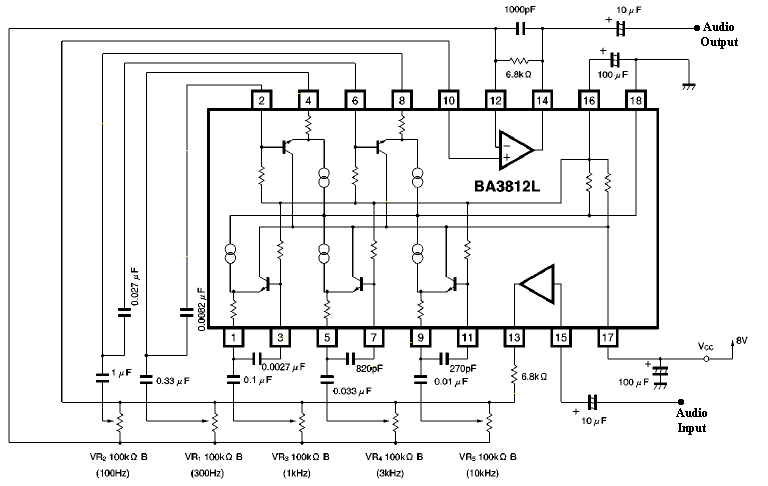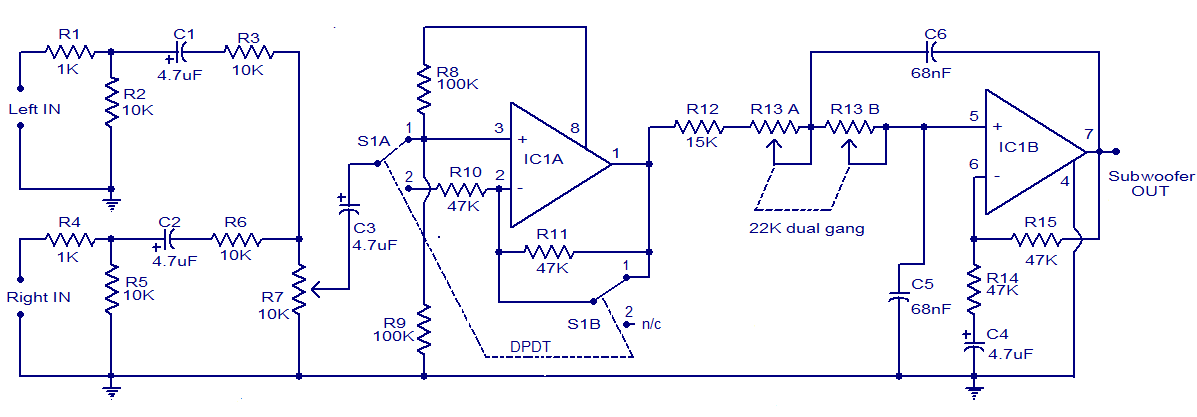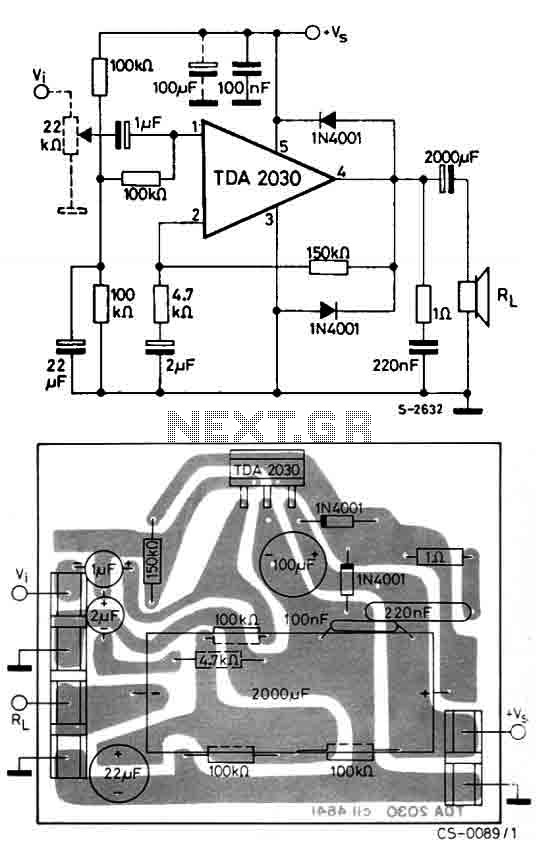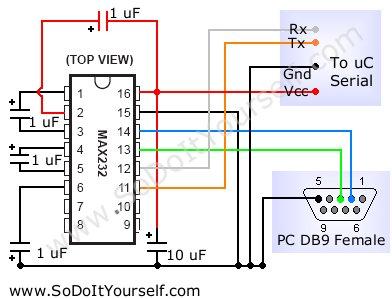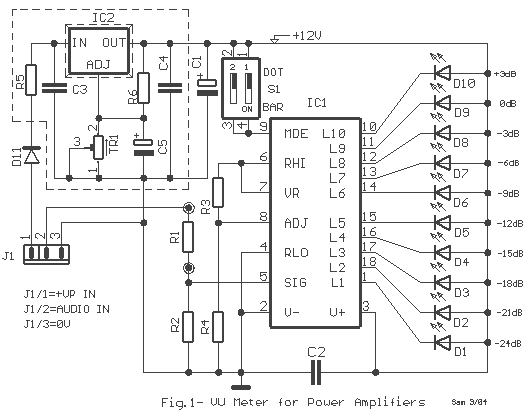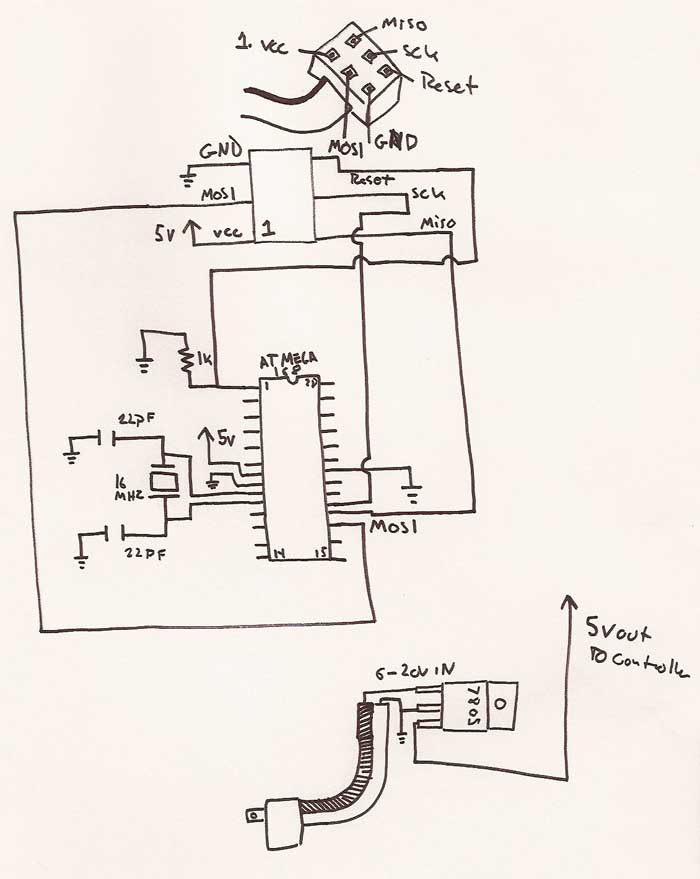
Audio VU Meter using Arduino
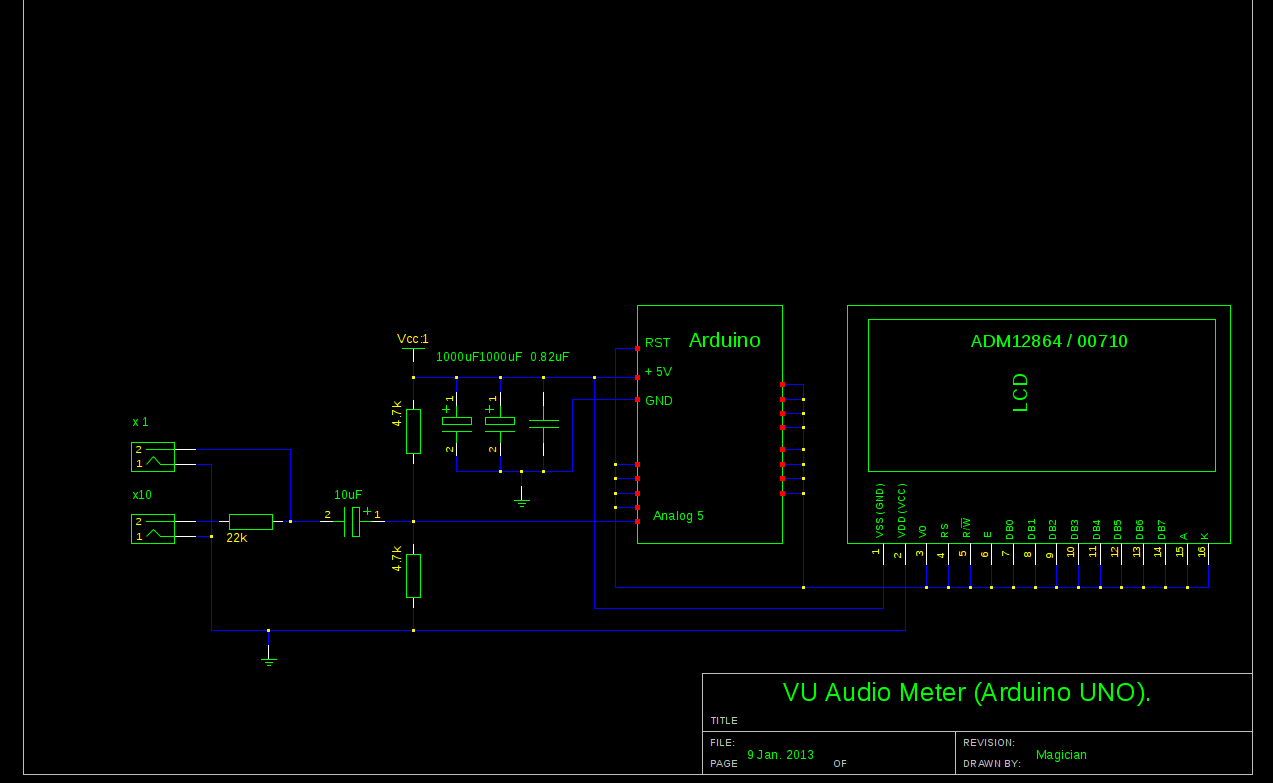
It is advisable to modify inexpensive USB speakers to obtain a pre-assembled analog front-end for this project. If this is not feasible, then soldering will be necessary, requiring a minimum of two resistors and one capacitor, assuming the display is already wired and operational. The initial task involves handling AC measurements (audio in this category) with an Atmel microcontroller to eliminate the negative half-wave of the input signal, which is the primary function of the front-end circuitry. There are at least two options: rectifying AC to DC before the voltage reaches the Arduino analog input, or biasing the signal with an external DC offset. Rectification can be effectively achieved using a specifically designed IC, such as the LM3914/15/16. However, this article will focus on the second alternative, as it would be unreasonable to request modification of the speakers and then instruct to solder another board. The setup described is a slightly modified version from the previous blog: when the AC input signal is combined with a DC offset, it remains in the positive range (consider a sine wave that oscillates between -1 and +1; adding +1 ensures it is always positive). This modification protects the Arduino from damage due to negative voltage. Once the Arduino's ADC completes the conversion from analog to digital, the DC offset is no longer necessary and should be subtracted. The sampling subroutine operates at 40 kHz, which is sufficient for any application. The sampling rate can be reduced to lessen CPU load; under current settings, VU metering consumes over 50% of CPU resources. A higher sampling rate enhances linearity and precision across a wide bandwidth, while even a 10 kHz sampling rate can achieve better than 1 dB accuracy with standard audio content. The entire input capture process occurs within an interrupt subroutine configured during setup. Two channels of Timer 1 are set to operate in parallel: channel A maintains a precise 40 kHz clock, while channel B triggers the start of the ADC conversion at the same frequency. Restarting the conversion via hardware minimizes phase noise compared to alternative methods.
The electronic schematic for this project involves an Atmel microcontroller interfaced with a modified USB speaker system. The main focus is on creating an analog front-end that allows the microcontroller to accurately process audio signals. The circuit should include a rectification stage or a biasing circuit to ensure that the audio signal remains within a safe voltage range for the microcontroller's analog input pins.
The rectification stage can be implemented using a precision rectifier configuration with operational amplifiers, if rectification is chosen. Alternatively, for the DC offset method, a simple voltage divider network can be employed to add a positive bias to the incoming audio signal. This biasing technique would typically involve two resistors and a capacitor to stabilize the DC level while allowing the AC audio signal to pass through.
Once the signal is conditioned, it can be fed into the analog input of the microcontroller. The ADC within the microcontroller will convert the conditioned signal into a digital representation. The sampling rate of 40 kHz ensures that the audio signal is captured accurately, providing sufficient resolution for most audio applications. In the interrupt routine, the ADC conversion is triggered by Timer 1, ensuring that the timing of the sampling is precise and consistent.
To further enhance the performance, the output from the ADC can be processed using digital signal processing techniques to extract meaningful audio features or to drive visual indicators such as LEDs for audio level monitoring. The entire setup should be powered appropriately, and care must be taken to ensure that the power supply does not introduce noise into the audio signals. Proper grounding and layout practices should be followed to minimize interference and maintain signal integrity throughout the circuit.Hope, you follow my advice and hack your cheap USB speakers, to get nice ( pre-assembled ! ) analog front-end for this project. If not, than get your soldering iron to work, minimum two resistors and 1 cap would required, assuming you already have display wired up and running. First things with AC measurements ( audio in this category ) on Atmel microcontroler is to get rid of negative half-wave of the input signal, and this what front-end circuitry should do. There are at least two option: rectifying AC to DC before voltage could reach arduino analog input, or biasing signal with external DC offset.
Rectification, could nicely be done with help of specifically design IC, LM3914 / 15 / 16 for example. But in this article, I`d describe second alternative, as it`d be not fare to ask you to hack your speakers and than tell you to solder another board .
Here is my set-up, slightly modified version from last blog: When AC input signal is mixed with DC offset, so it stays always in positive area, ( think about sine, which defined betseen -1 and +1, if I add +1 it always would be positive ), I only save arduino life, preventing it from destruction by negative voltage. When arduino ADC completes conversion from analog to digital form, I don`t need DC offset anymore, and it should be subtracted.
2. Sampling subroutine is running at 40 kHz, that is more than enough for ANY application. You may decrease sampling rate to lower CPU load, with current settings VU metering consumes more than 50%. Higher sampling rate gives better linearity / precision over wide band, the same time with regular audio content even 10 kHz sampling would provide better than 1 dB accuracy.
All input capture process goes in Interruption subroutine, which is configured in setup. Two channels of Timer 1 Configured to run in parallel, A is responsible to keep clock at 40 kHz sharp, and B fires start conversion event to ADC with the same speed. Restarting new conversion via hardware provides lowest phase noise compare to any other way of doing this.
🔗 External reference
The electronic schematic for this project involves an Atmel microcontroller interfaced with a modified USB speaker system. The main focus is on creating an analog front-end that allows the microcontroller to accurately process audio signals. The circuit should include a rectification stage or a biasing circuit to ensure that the audio signal remains within a safe voltage range for the microcontroller's analog input pins.
The rectification stage can be implemented using a precision rectifier configuration with operational amplifiers, if rectification is chosen. Alternatively, for the DC offset method, a simple voltage divider network can be employed to add a positive bias to the incoming audio signal. This biasing technique would typically involve two resistors and a capacitor to stabilize the DC level while allowing the AC audio signal to pass through.
Once the signal is conditioned, it can be fed into the analog input of the microcontroller. The ADC within the microcontroller will convert the conditioned signal into a digital representation. The sampling rate of 40 kHz ensures that the audio signal is captured accurately, providing sufficient resolution for most audio applications. In the interrupt routine, the ADC conversion is triggered by Timer 1, ensuring that the timing of the sampling is precise and consistent.
To further enhance the performance, the output from the ADC can be processed using digital signal processing techniques to extract meaningful audio features or to drive visual indicators such as LEDs for audio level monitoring. The entire setup should be powered appropriately, and care must be taken to ensure that the power supply does not introduce noise into the audio signals. Proper grounding and layout practices should be followed to minimize interference and maintain signal integrity throughout the circuit.Hope, you follow my advice and hack your cheap USB speakers, to get nice ( pre-assembled ! ) analog front-end for this project. If not, than get your soldering iron to work, minimum two resistors and 1 cap would required, assuming you already have display wired up and running. First things with AC measurements ( audio in this category ) on Atmel microcontroler is to get rid of negative half-wave of the input signal, and this what front-end circuitry should do. There are at least two option: rectifying AC to DC before voltage could reach arduino analog input, or biasing signal with external DC offset.
Rectification, could nicely be done with help of specifically design IC, LM3914 / 15 / 16 for example. But in this article, I`d describe second alternative, as it`d be not fare to ask you to hack your speakers and than tell you to solder another board .
Here is my set-up, slightly modified version from last blog: When AC input signal is mixed with DC offset, so it stays always in positive area, ( think about sine, which defined betseen -1 and +1, if I add +1 it always would be positive ), I only save arduino life, preventing it from destruction by negative voltage. When arduino ADC completes conversion from analog to digital form, I don`t need DC offset anymore, and it should be subtracted.
2. Sampling subroutine is running at 40 kHz, that is more than enough for ANY application. You may decrease sampling rate to lower CPU load, with current settings VU metering consumes more than 50%. Higher sampling rate gives better linearity / precision over wide band, the same time with regular audio content even 10 kHz sampling would provide better than 1 dB accuracy.
All input capture process goes in Interruption subroutine, which is configured in setup. Two channels of Timer 1 Configured to run in parallel, A is responsible to keep clock at 40 kHz sharp, and B fires start conversion event to ADC with the same speed. Restarting new conversion via hardware provides lowest phase noise compare to any other way of doing this.
🔗 External reference
